Observation of the Relationship between Ocean Bathymetry and Acoustic Bearing-Time Record Patterns Acquired during a Reverberation Experiment in the Southwestern Continental Margin of the Ulleung Basin, Korea
Abstract
:1. Introduction
2. ATASS 15 Description
2.1. Experimental Description and Ocean Environment
2.2. Bathymetry and Geoacoustic Modeling
2.3. Structure of Acoustic Propagation in Water
3. Results and Discussion
3.1. Triplet Array Beamforming
3.2. Bearing-Time Record Pattern
3.3. Simulation
3.4. Discussion
4. Conclusions
Author Contributions
Funding
Institutional Review Board Statement
Informed Consent Statement
Acknowledgments
Conflicts of Interest
References
- Lee, K.; Seong, W.; Kim, S. Estimation of the roll angle in a triplet towed array using oceanic surface-generated ambient noise. J. Acoust. Soc. Am. 2017, 142, EL123–EL129. [Google Scholar] [CrossRef]
- Jung, Y.; Seong, W.; Lee, K.; Kim, S. A Depth-Bistatic Bottom Reverberation Model and Comparison with Data from an Active Triplet Towed Array Experiment. Appl. Sci. 2020, 10, 3080. [Google Scholar] [CrossRef]
- Yang, J.; Tang, D.; Hefner, H.B.T.; Williams, K.L.; Preston, J.R. Overview of Midfrequency Reverberation Data Acquired During the Target and Reverberation Experiment 2013. IEEE J. Ocean. Eng. 2018, 43, 563–585. [Google Scholar] [CrossRef]
- Preston, J.R.; Akal, T.; Berkson, J. Analysis of backscattering data in the Tyrrhenian Sea. J. Acoust. Soc. Am. 1990, 87, 119–134. [Google Scholar] [CrossRef]
- Preston, J.R.; Ellis, D.D. Extracting bottom information from towed-array reverberation data Part I: Measurement methodology. J. Mar. Syst. 2009, 78, S359–S371. [Google Scholar] [CrossRef]
- Makris, N.C.; Berkson, J.M. Long-range backscatter from the Mid-Atlantic Ridge. J. Acoust. Soc. Am. 1994, 95, 1865–1881. [Google Scholar] [CrossRef] [Green Version]
- Makris, N.C.; Avelino, L.Z.; Menis, R. Deterministic reverberation from ocean ridges. J. Acoust. Soc. Am. 1995, 97, 3547–3574. [Google Scholar] [CrossRef]
- Smith, K.B.; Hodgkiss, W.S.; Tappert, F.D. Propagation and analysis issues in the prediction of long-range reverberation. J. Acoust. Soc. Am. 1996, 99, 1387–1404. [Google Scholar] [CrossRef]
- Preston, J.R. Reverberation at the Mid-Atlantic Ridge during the 1993 ARSRP experiment seen by R/V Alliance from 200–1400 Hz and some modeling inferences. J. Acoust. Soc. Am. 2000, 107, 237–259. [Google Scholar] [CrossRef] [PubMed]
- Ratilal, P.; Lai, Y.; Symonds, D.T.; Ruhlmann, L.A.; Preston, J.R.; Scheer, E.K.; Garr, M.T.; Holland, C.W.; Goff, J.A.; Makris, N.C. Long range acoustic imaging of the continental shelf environment: The Acoustic Clutter Reconnaissance Experiment 2001. J. Acoust. Soc. Am. 2005, 117, 1977–1998. [Google Scholar] [CrossRef]
- Preston, J.R. Using Triplet Arrays for Broadband Reverberation Analysis and Inversions. IEEE J. Ocean. Eng. 2007, 32, 879–896. [Google Scholar] [CrossRef]
- Holland, C.W.; Gauss, R.C.; Hines, P.C.; Nielsen, P.; Preston, J.R.; Harrison, C.H.; Ellis, D.D.; Lepage, K.D.; Osler, J.; Nero, R.W.; et al. Boundary Characterization Experiment Series Overview. IEEE J. Ocean. Eng. 2005, 30, 784–806. [Google Scholar] [CrossRef]
- Holland, C.W.; Preston, J.R.; Abraham, D.A. Long-range acoustic scattering from a shallow-water mud-volcano cluster. J. Acoust. Soc. Am. 2007, 122, 1946. [Google Scholar] [CrossRef] [PubMed]
- Ellis, D.D.; Yang, J.; Preston, J.R.; Pecknold, S. A Normal Mode Reverberation and Target Echo Model to Interpret Towed Array Data in the Target and Reverberation Experiments. IEEE J. Ocean. Eng. 2017, 42, 344–361. [Google Scholar] [CrossRef]
- Yang, J.; Tang, D. Direct Measurements of Sediment Sound Speed and Attenuation in the Frequency Band of 2–8 kHz at the Target and Reverberation Experiment Site. IEEE J. Ocean. Eng. 2017, 42, 1102–1109. [Google Scholar] [CrossRef]
- Hefner, B.T.; Hodgkiss, W.S. Reverberation due to a moving, narrowband source in an ocean waveguide. J. Acoust. Soc. Am. 2019, 146, 1661–1670. [Google Scholar] [CrossRef]
- Hefner, B.T. Characterization of Seafloor Roughness to Support Modeling of Midfrequency Reverberation. IEEE J. Ocean. Eng. 2017, 42, 1110–1124. [Google Scholar] [CrossRef]
- Chough, S.K.; Lee, H.J.; Yoon, S.H. Marine Geology of Korean Seas; Elsevier: Amsterdam, The Netherland, 2000. [Google Scholar]
- Chough, S.K.; Lee, S.H.; Kim, J.W.; Park, S.C.; Yoo, D.G.; Han, H.S.; Yoon, S.H.; Oh, S.B.; Kim, Y.B.; Back, G.G. Chirp (2–7 kHz) echo characters in the Ulleung Basin. Geosci. J. 1997, 1, 143–153. [Google Scholar] [CrossRef]
- GEBCO. General Bathymetric Chart of the Oceans. Available online: https://www.gebco.net/ (accessed on 28 September 2021).
- Barbagelata, A.; Guerrini, P.; Toiano, L. Thirty years of towed arrays at NURC. Oceanography 2008, 21, 24–33. [Google Scholar] [CrossRef]
- Koo, B.; Kim, S.; Lee, G.; Chung, G.S. Seafloor Morphology and Surface Sediment Distribution of the Southwestern Part of the Ulleung Basin, East Sea. J. Korean Earth Sci. Soc. 2014, 35, 131–146. [Google Scholar] [CrossRef] [Green Version]
- Kim, S. Geoacoustic characteristics and sedimentary environments in the southwestern part of the Ulleung Basin, the East Sea. M.D. Dissertation, Pukyong National Univerisity, Busan, Korea, 2013. (In Korean). [Google Scholar]
- Lee, H.J.; Chough, S.S.; Chun, S.; Han, S.R. Sediment failure on the Korea Plateau slope, East Sea (Sea of Japan). Mar. Geol. 1991, 97, 363–377. [Google Scholar] [CrossRef]
- Lee, H.; Chun, S.; Yoon, S.H.; Kim, S. Slope stability and geotechnical properties of sediment of the southern margin of Ulleung Basin, East Sea (Sea of Japan). Mar. Geol. 1993, 110, 31–45. [Google Scholar] [CrossRef]
- Lee, H.J.; Chough, S.K.; Yoon, S.H. Slope-stability from late Pleistocene to Holocene in the Ulleung Basin, East Sea (Sea of Japan). Sediment. Geol. 1996, 104, 39–51. [Google Scholar] [CrossRef]
- Kim, G.; Kim, D.; Kim, J. Ultrasonic characterization of fluid mud: Effect of temperature. J. Acoust. Soc. Korea 2004, 23, 140–145. [Google Scholar]
- Hamilton, E.L. Geoacoustic modeling of the sea floor. J. Acoust. Soc. Am. 1980, 68, 1313–1340. [Google Scholar] [CrossRef]
- Kim, S.; Kim, D.; Lee, G. Correcting the Sound Velocity of the Sediments in the Southwestern Part of the East Sea Korea. J. Korean Earth Sci. Soc. 2016, 37, 408–419. [Google Scholar] [CrossRef]
- Harrison, C.H. Closed-form expressions for ocean reverberation and signal excess with mode stripping and Lambert’s law. J. Acoust. Soc. Am. 2003, 114, 2744–2756. [Google Scholar] [CrossRef]
- Harrison, C.H. Closed Form Bistatic Reverberation and Target Echoes with Variable Bathymetry and Sound Speed. IEEE J. Ocean. Eng. 2005, 30, 660–675. [Google Scholar] [CrossRef]
- Seo, S.N. Digital 30 sec gridded bathymetric data of Korean marginal seas-KorBathy 30s. J. Korean Soc. Coast. Ocean. Eng. 2008, 20, 110–120. [Google Scholar]

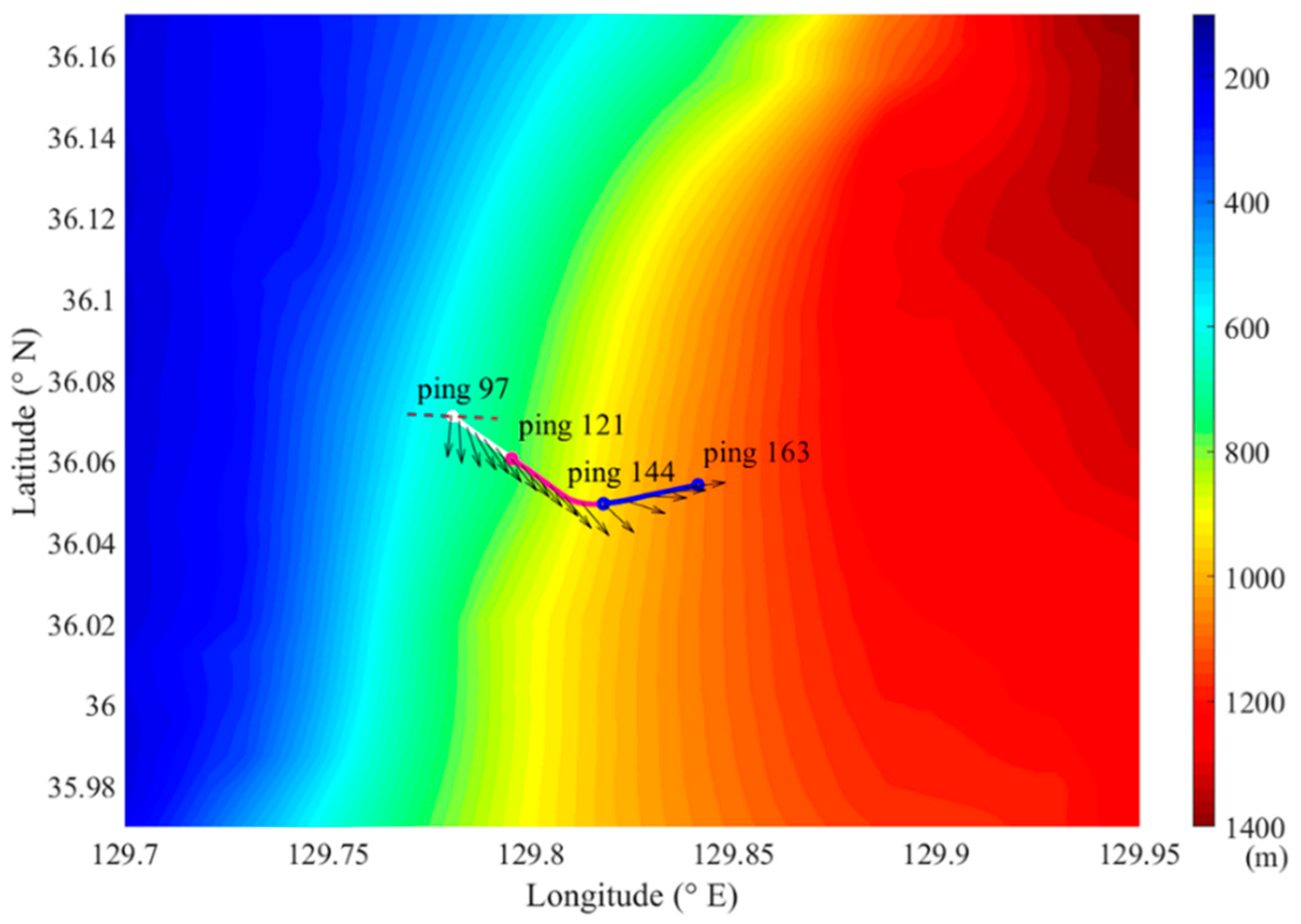
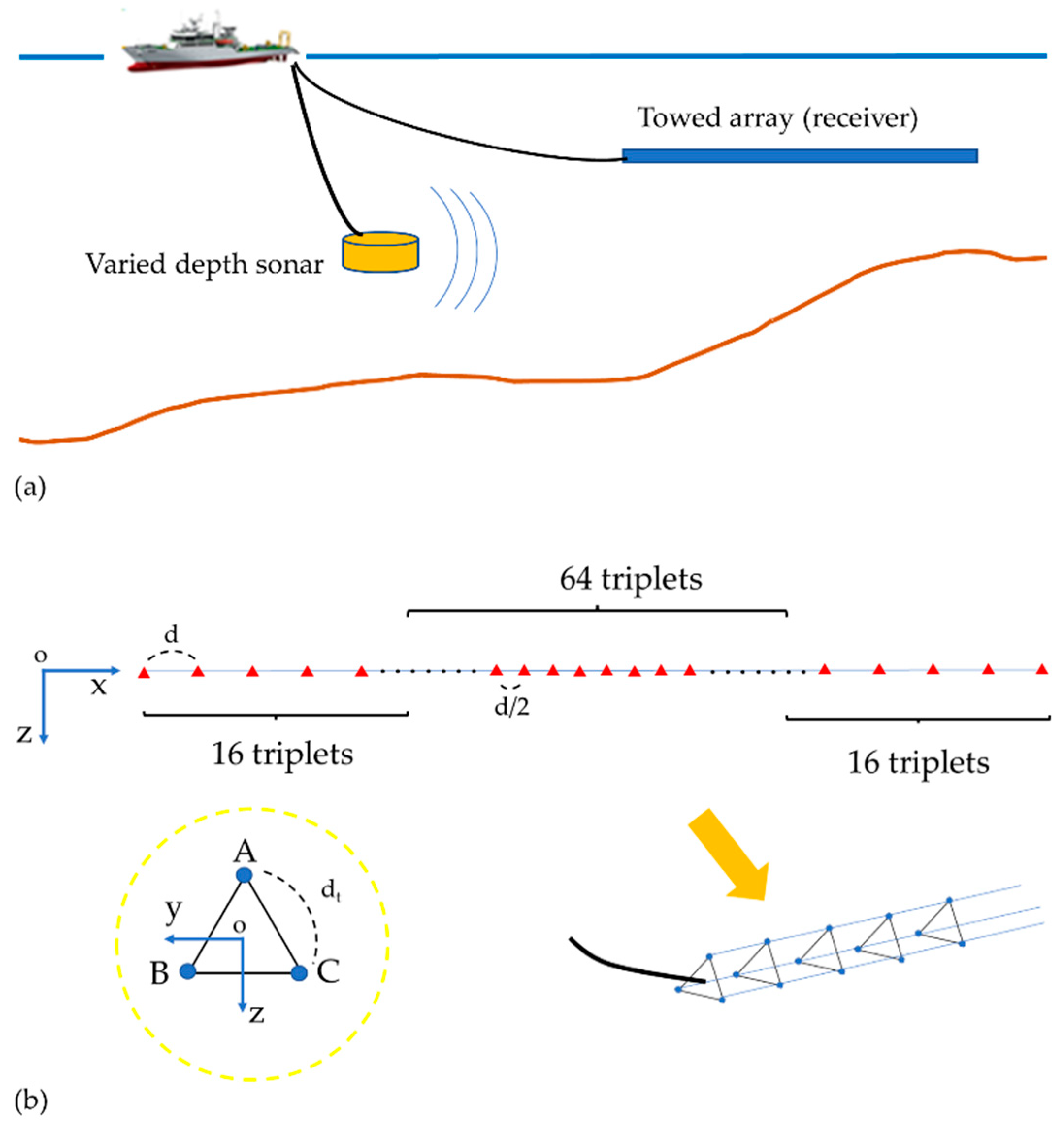
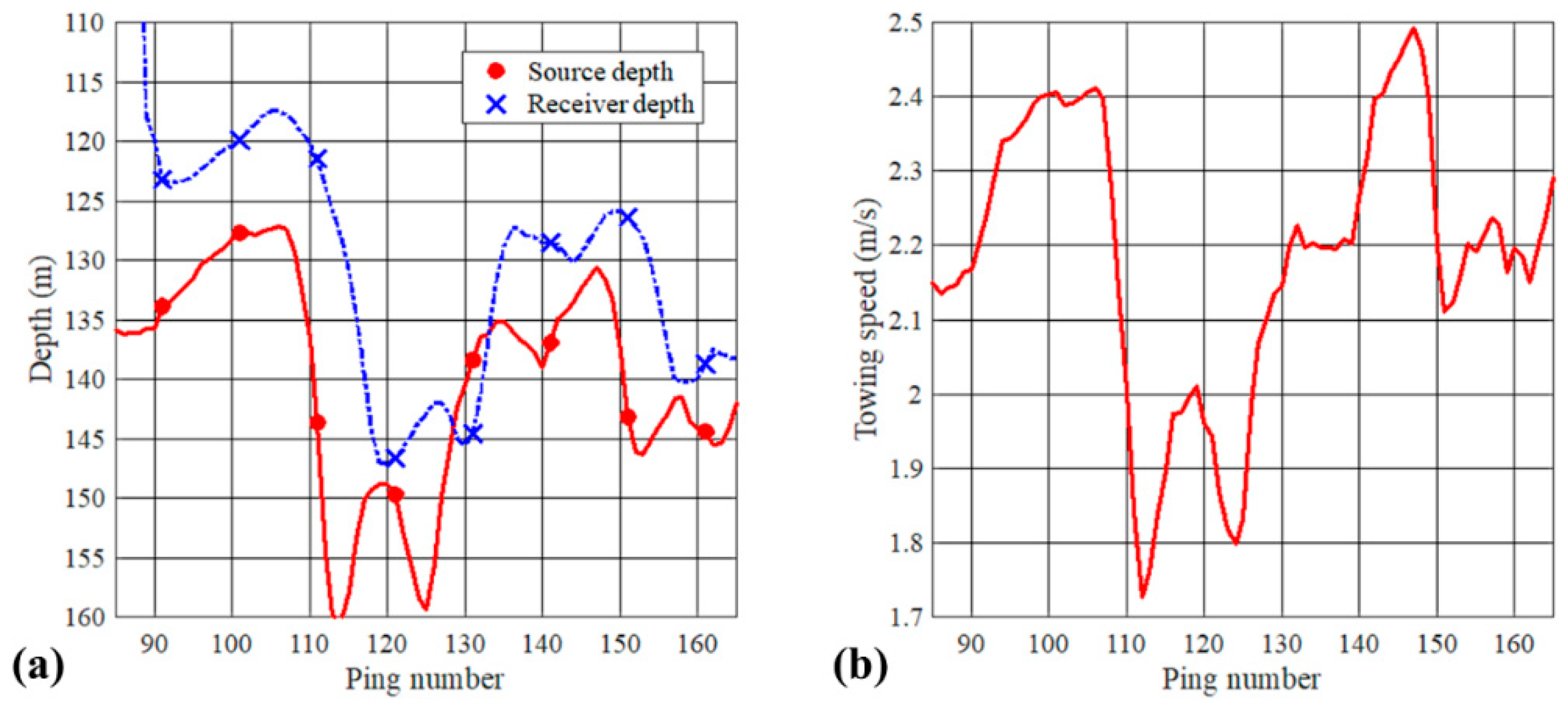
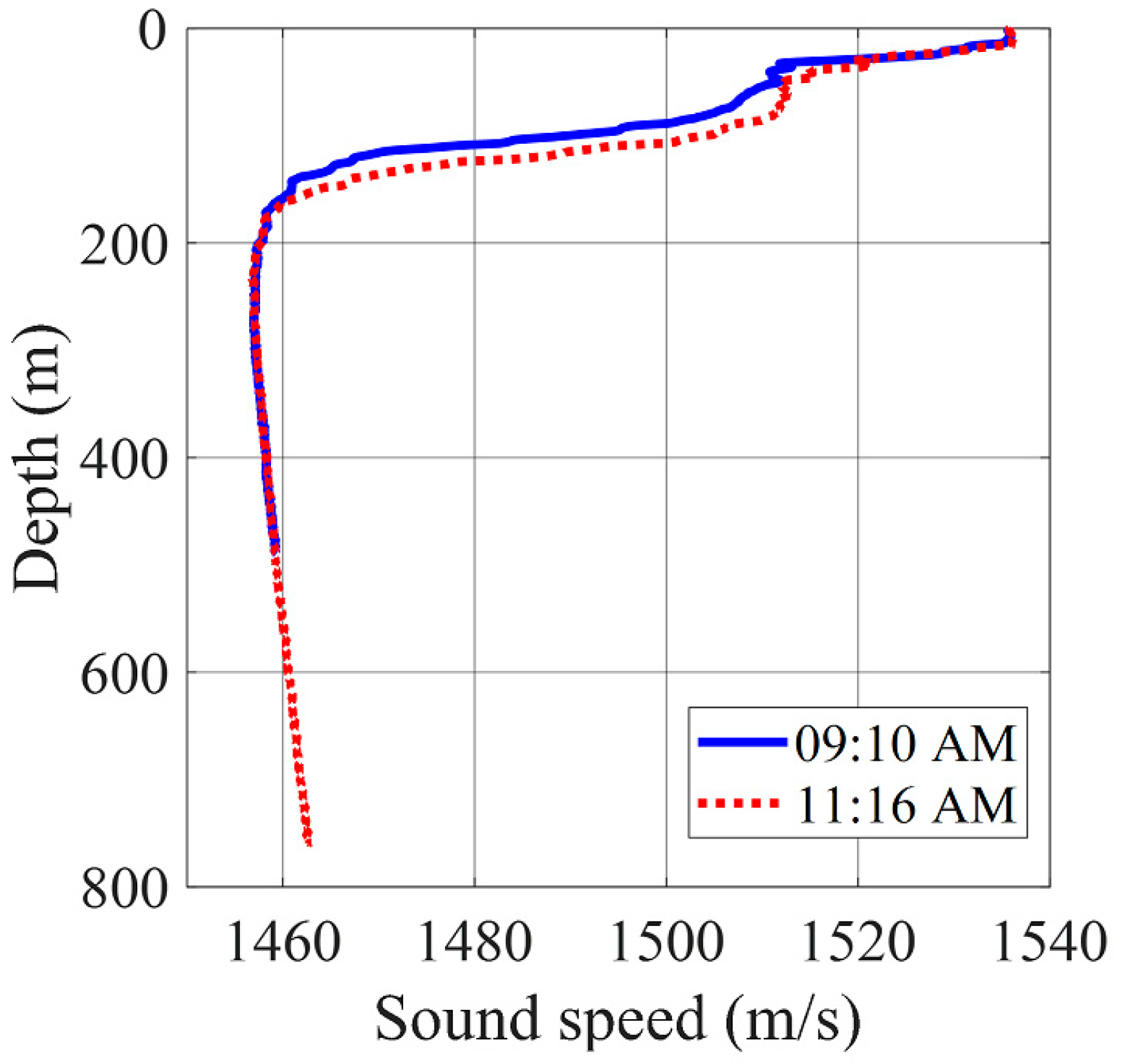
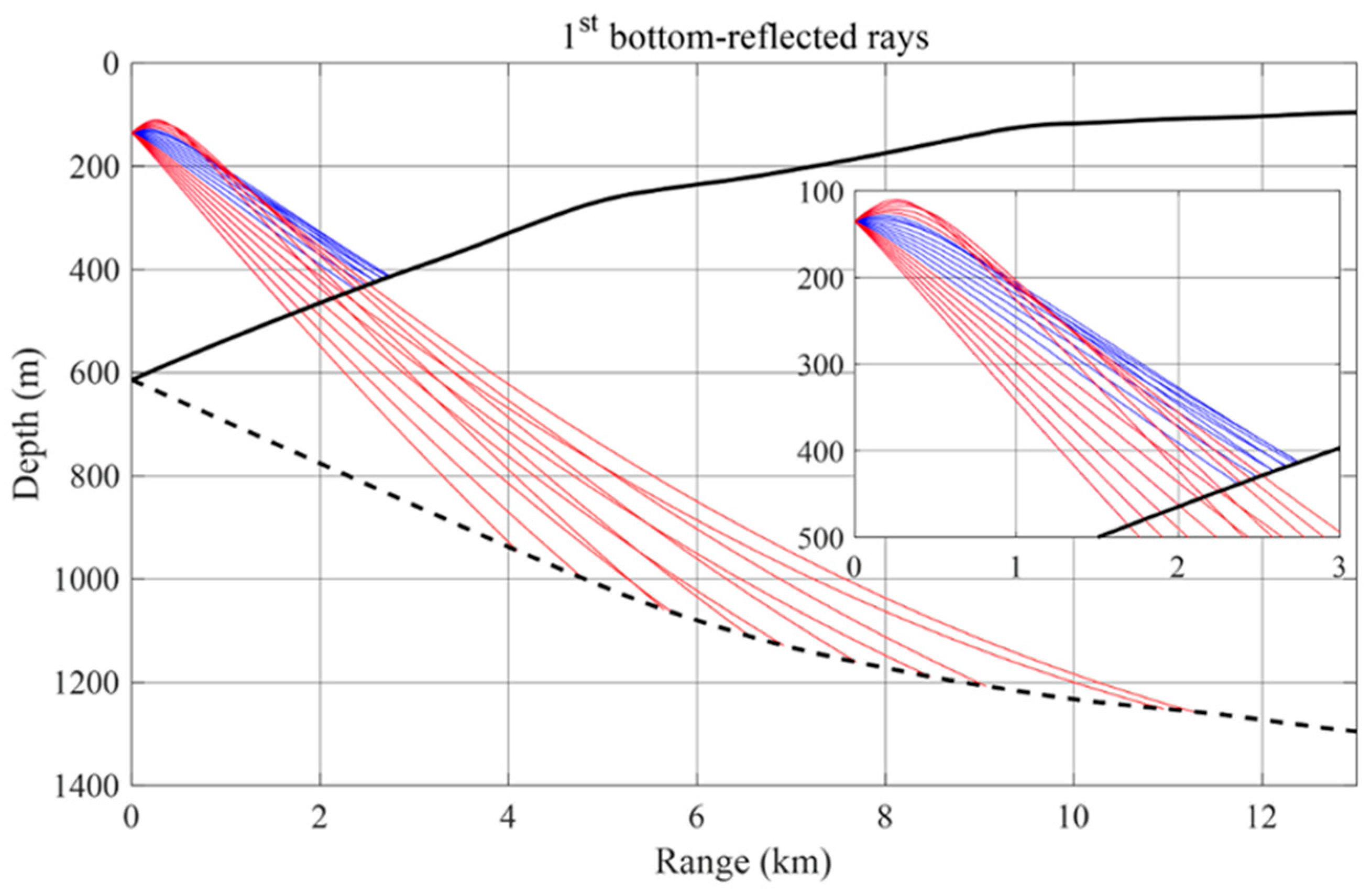
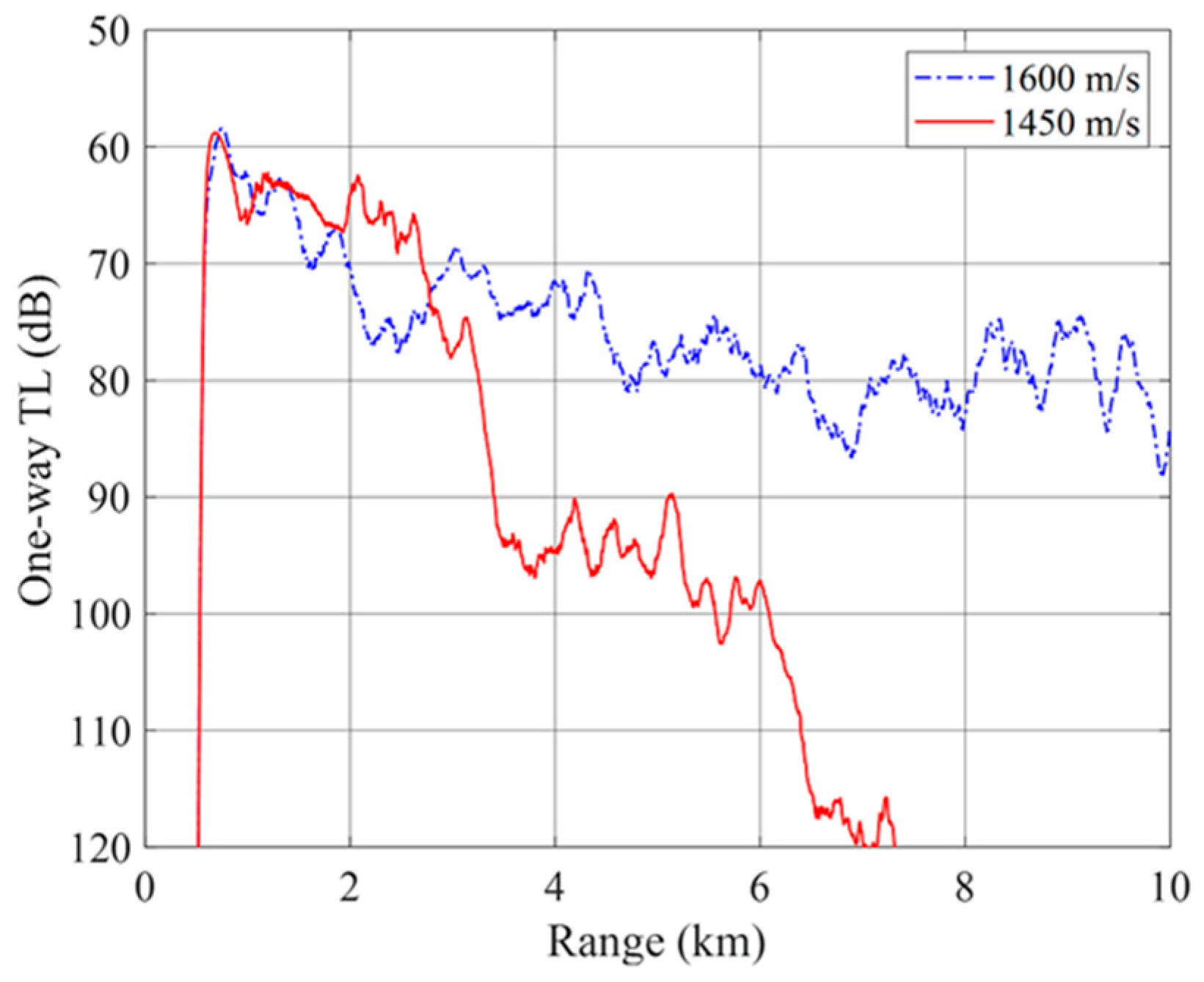
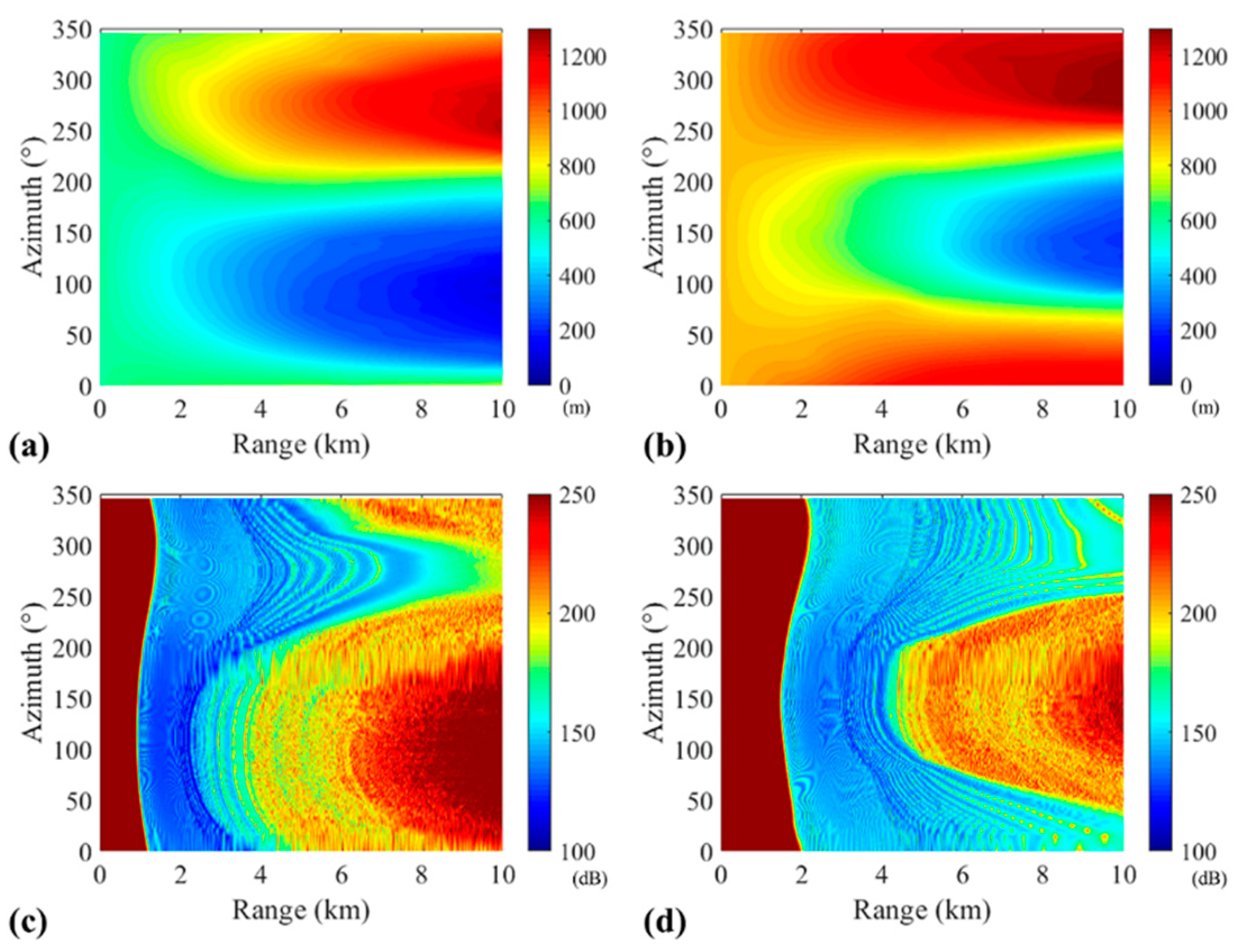
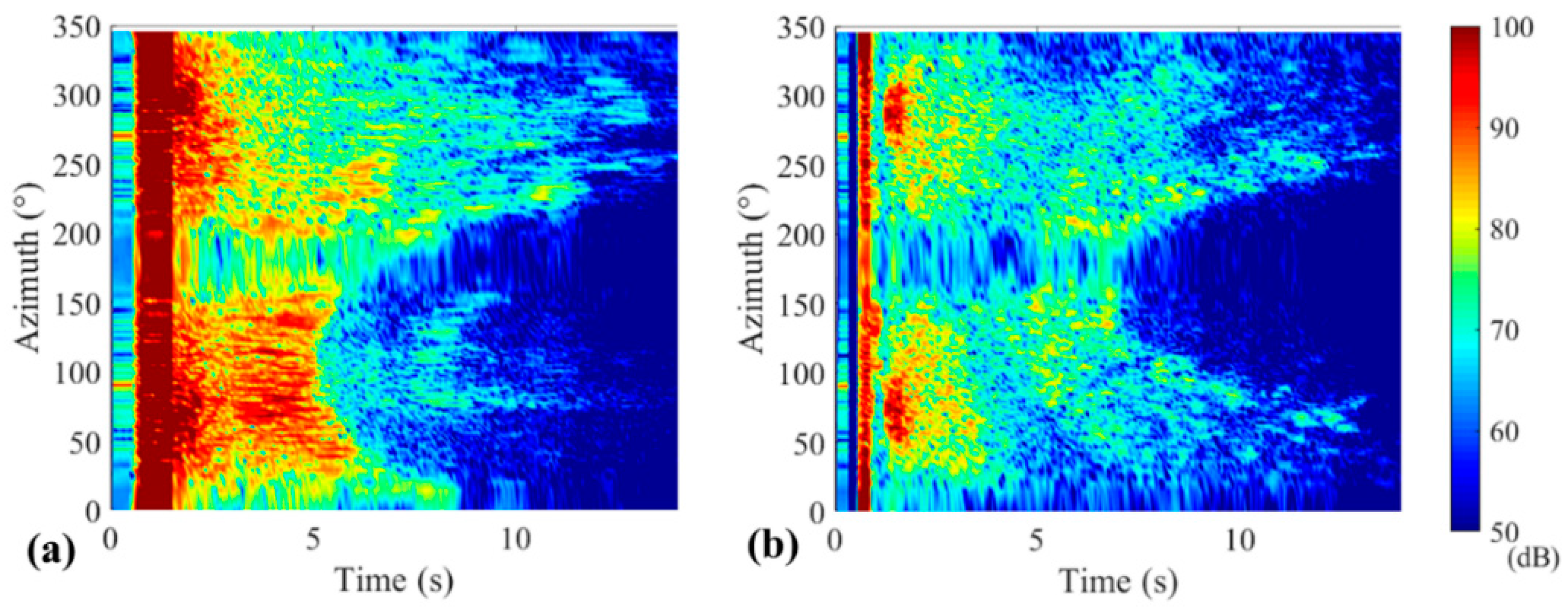
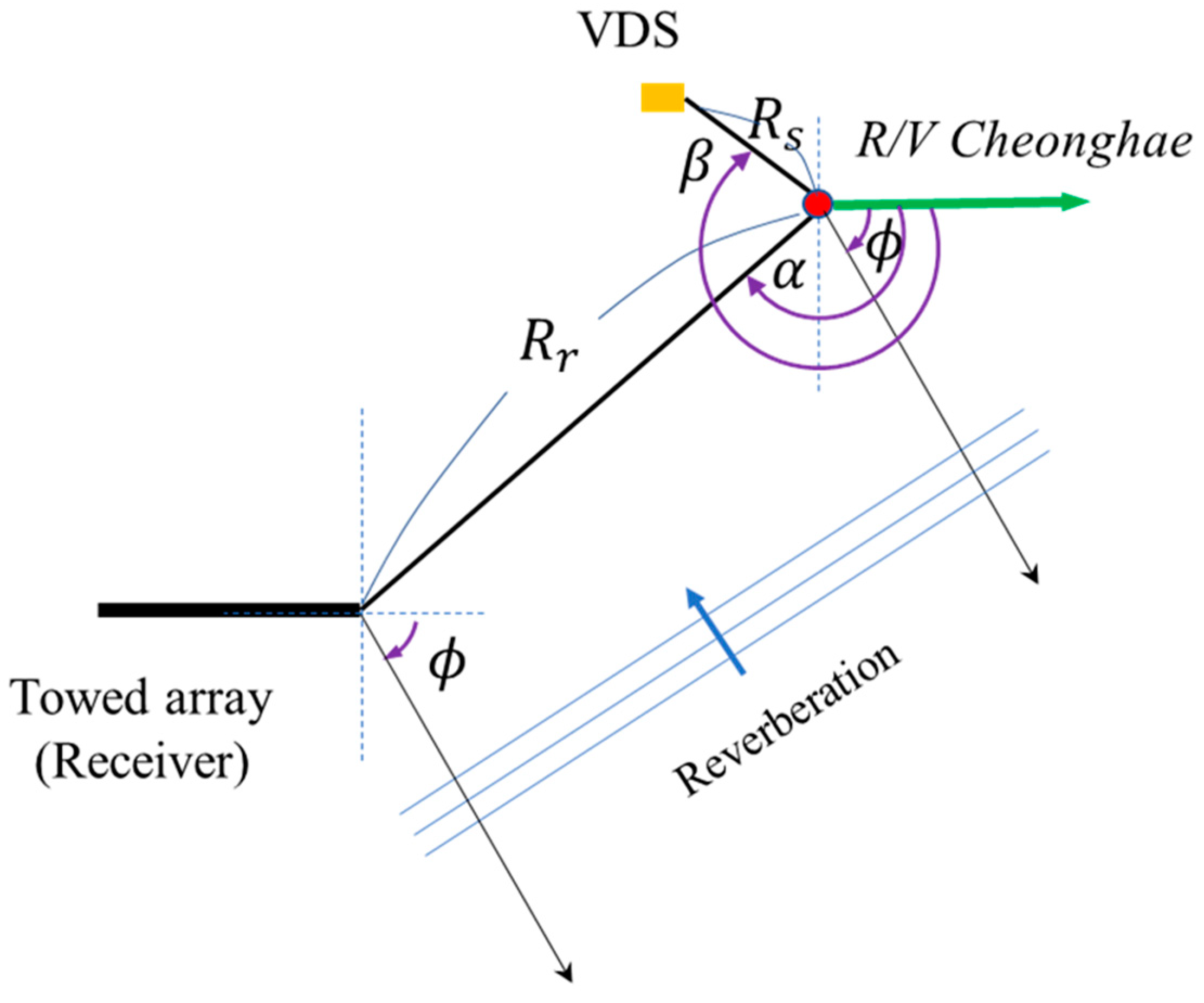
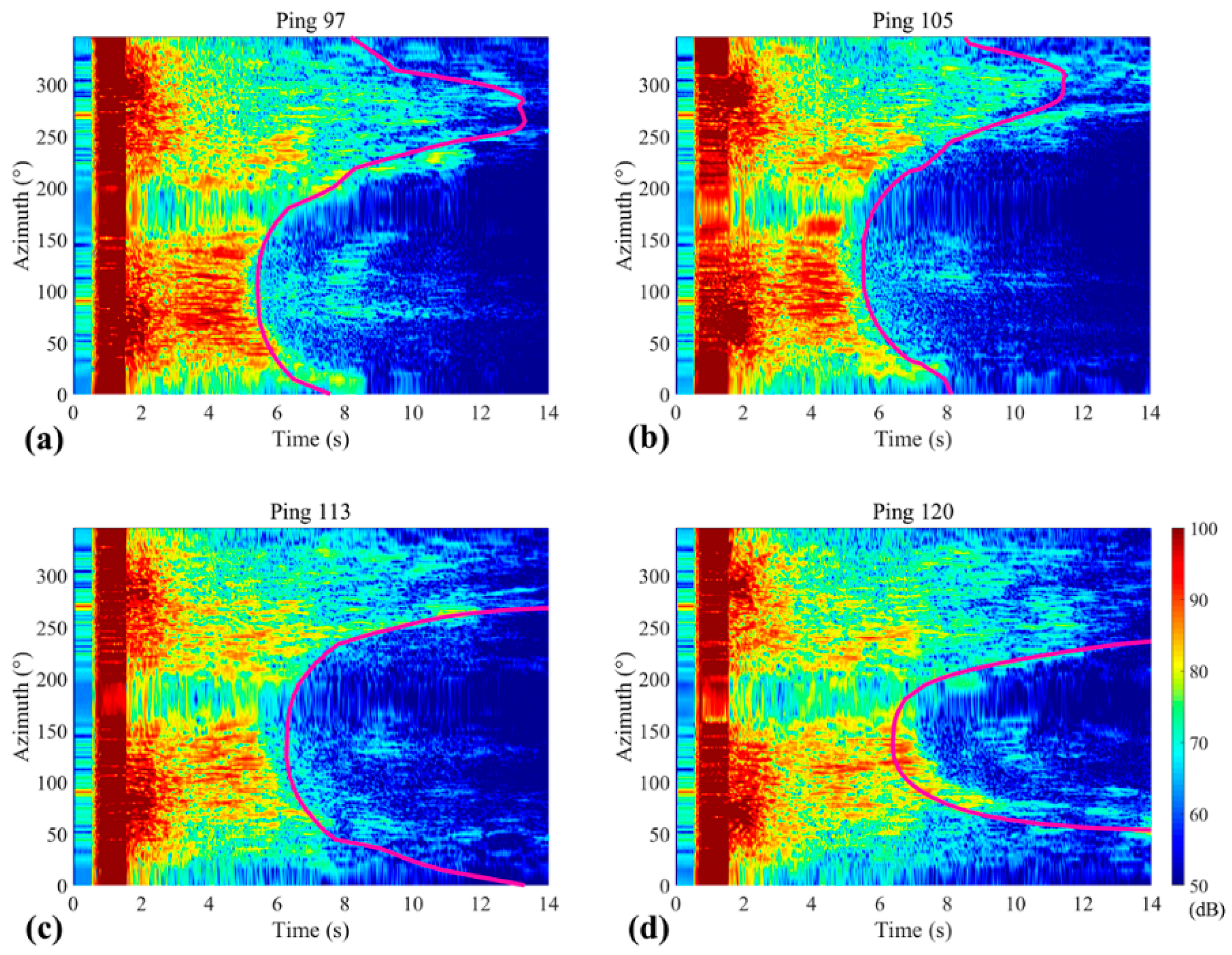
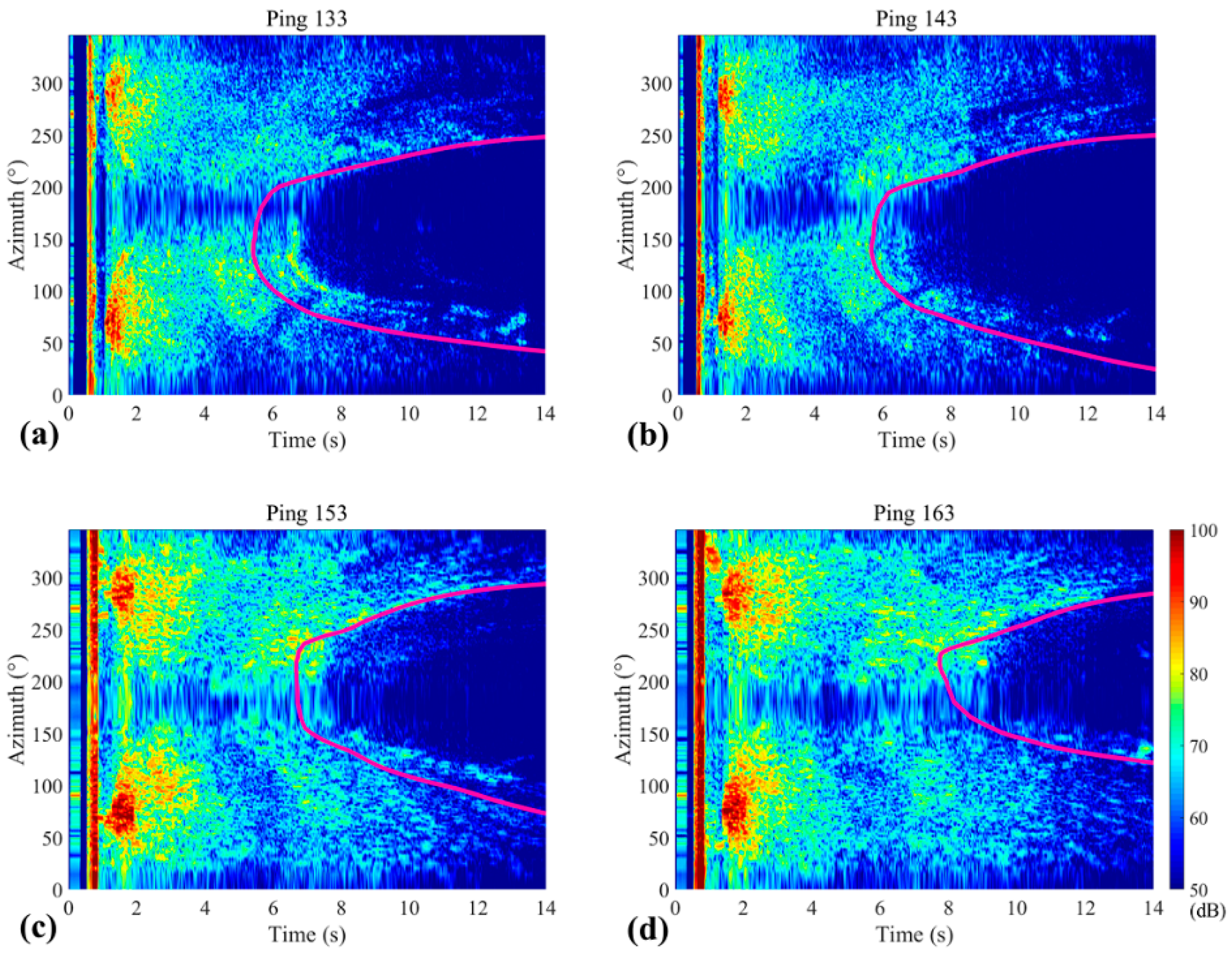
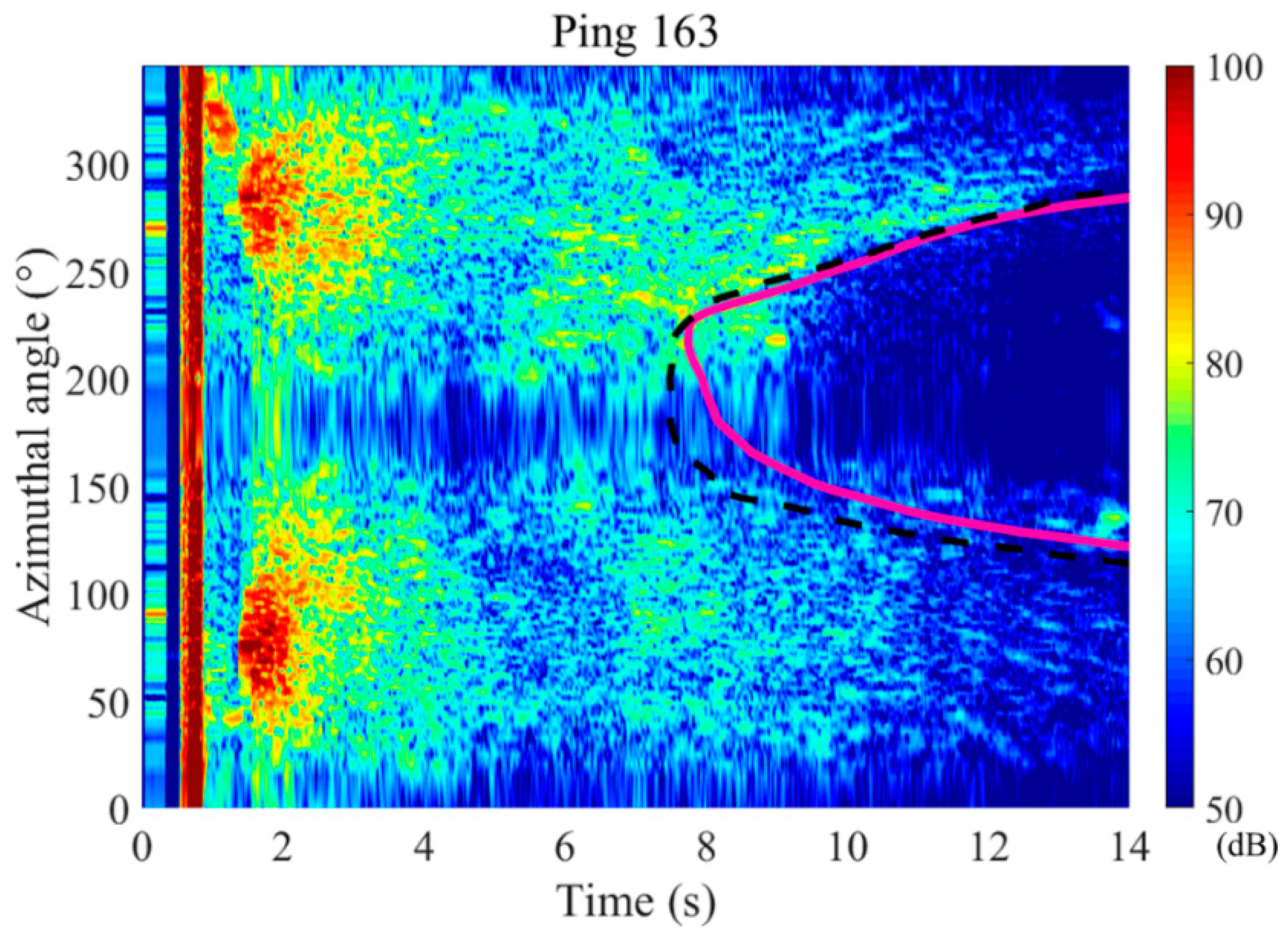
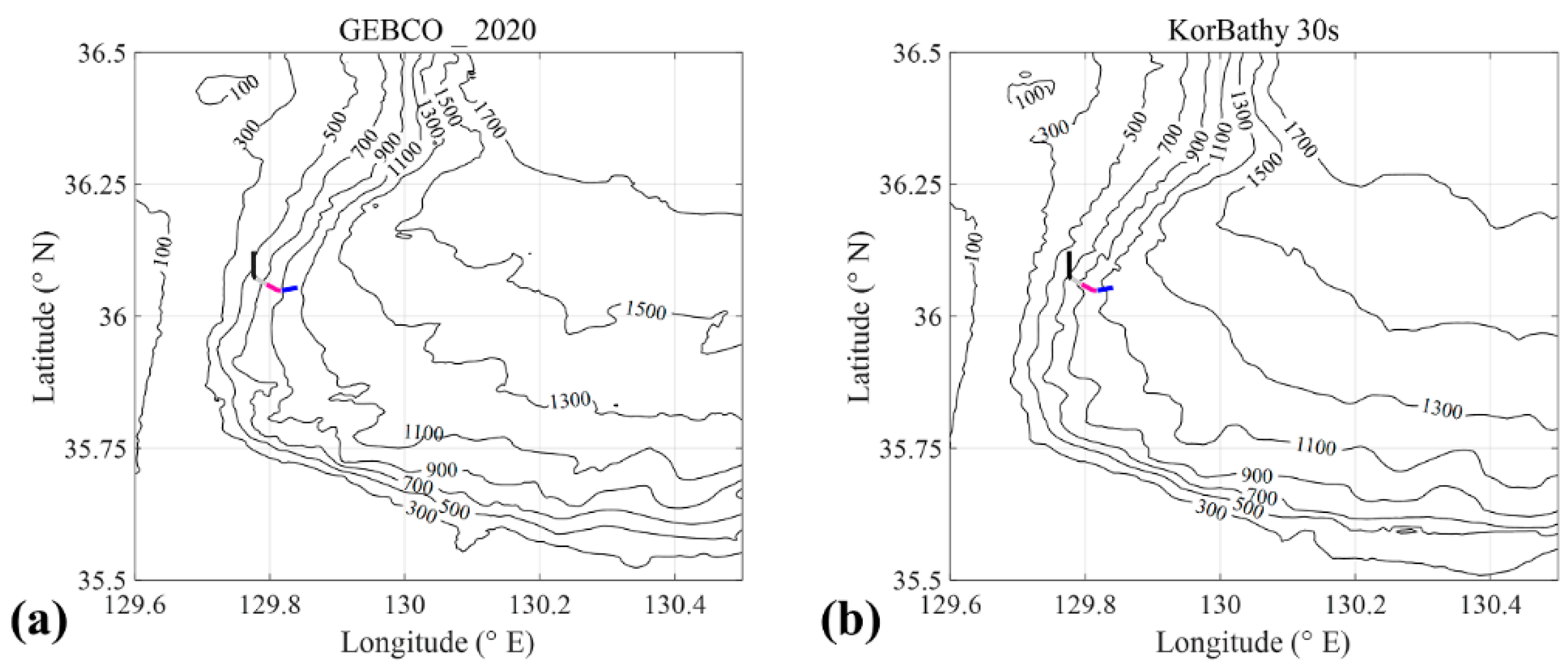
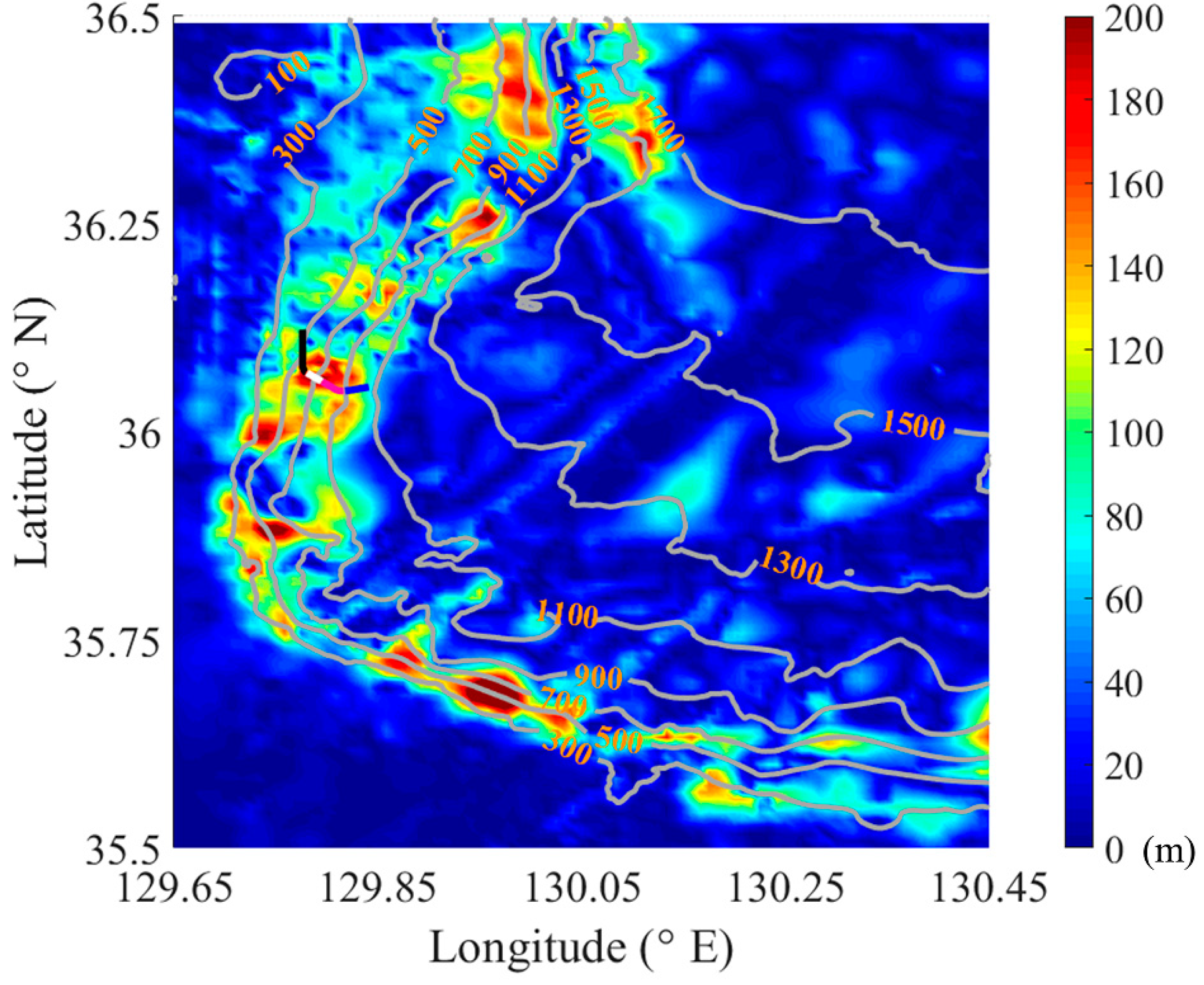
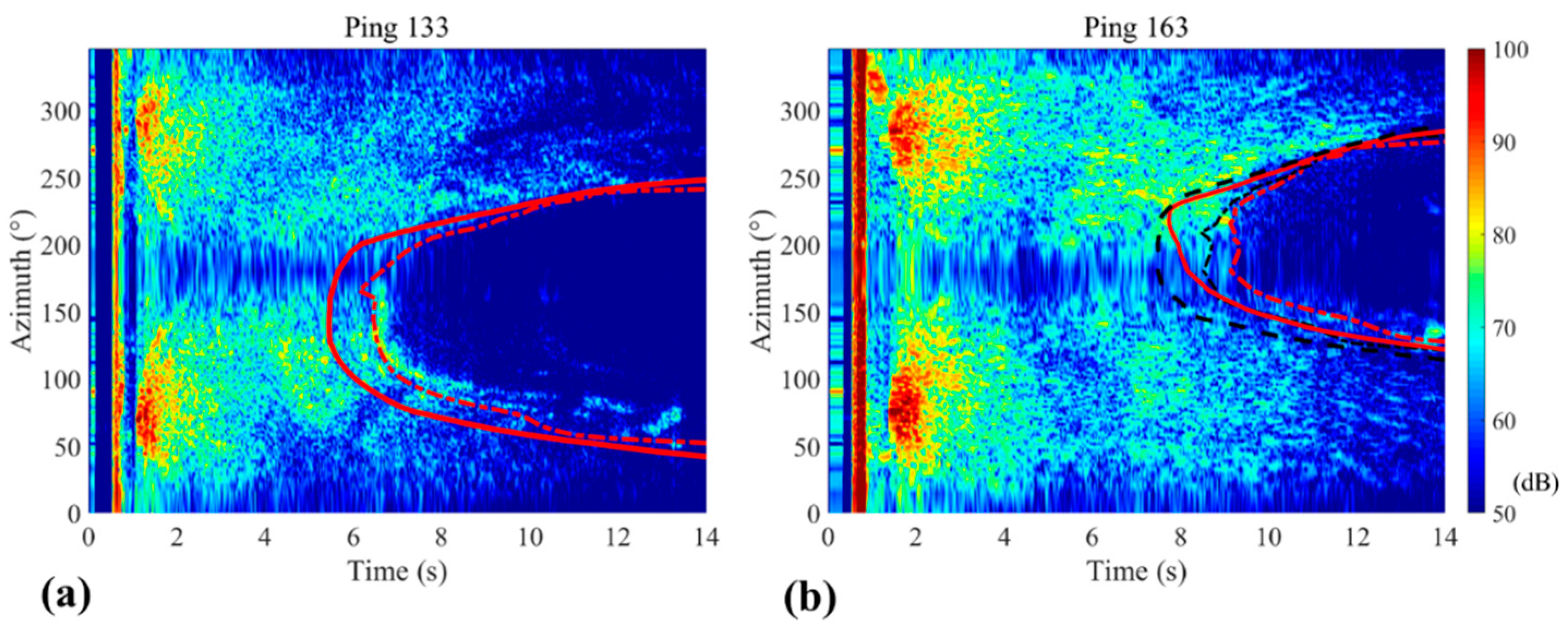
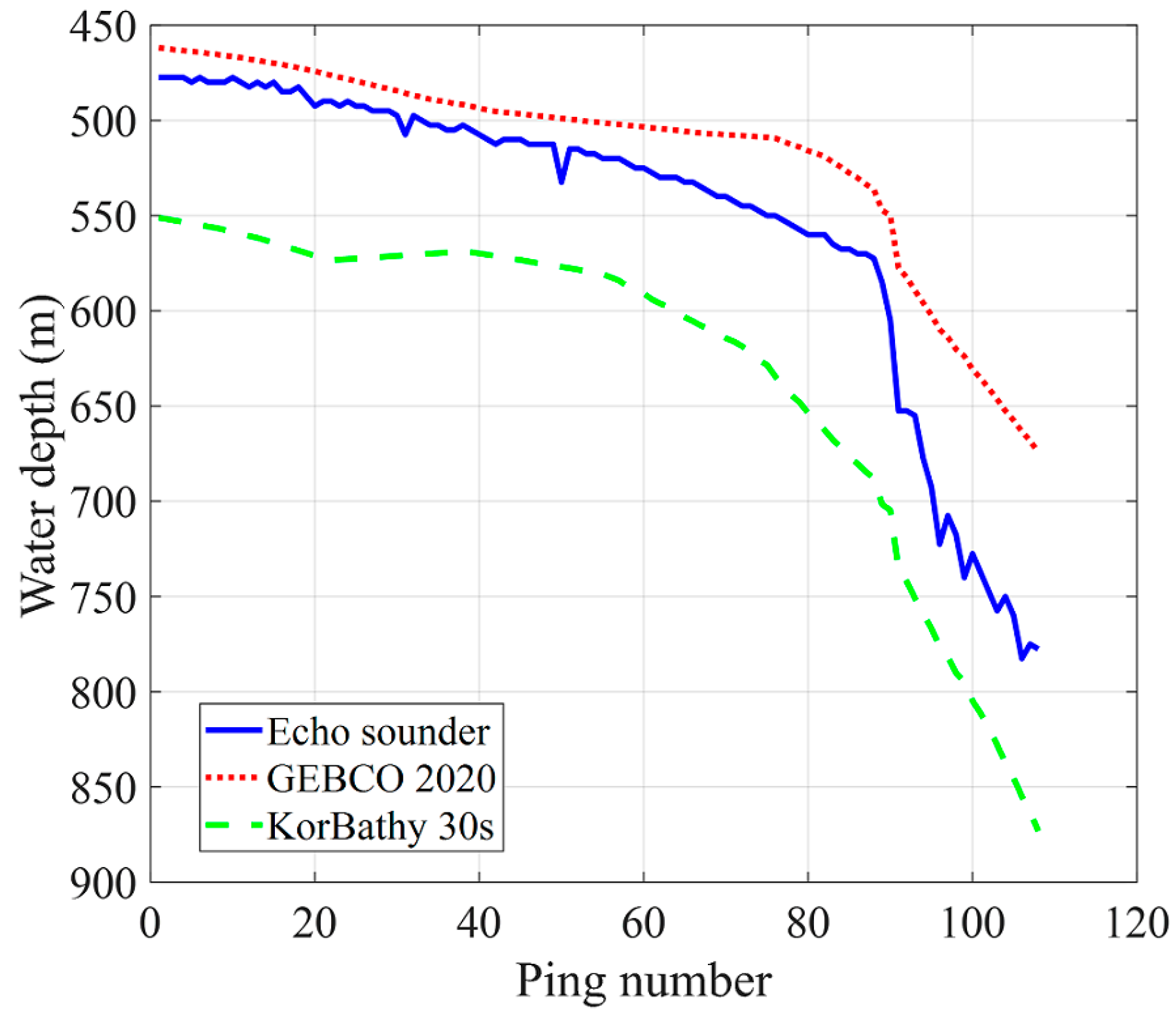
| Group | Ping # | Center Frequency (kHz) | Pulse Length (s) | Pulse Repetition Time (s) | Source Depth (m) | Receiver Depth (m) | Max. Ship Speed (m/s) |
|---|---|---|---|---|---|---|---|
| A | 97–110 | 3.0 | 1.0 | 25 | 127–139 | 117–122 | 2.44 |
| A | 111–120 | 3.0 | 1.0 | 50 | 141–161 | 121–147 | 2.03 |
| B | 121–143 | 3.0 | 0.1 | 50 | 134–160 | 127–147 | 2.44 |
| C | 144–163 | 3.0 | 0.3 | 50 | 130–146 | 126–140 | 2.50 |
Publisher’s Note: MDPI stays neutral with regard to jurisdictional claims in published maps and institutional affiliations. |
© 2021 by the authors. Licensee MDPI, Basel, Switzerland. This article is an open access article distributed under the terms and conditions of the Creative Commons Attribution (CC BY) license (https://creativecommons.org/licenses/by/4.0/).
Share and Cite
Jung, Y.; Lee, K. Observation of the Relationship between Ocean Bathymetry and Acoustic Bearing-Time Record Patterns Acquired during a Reverberation Experiment in the Southwestern Continental Margin of the Ulleung Basin, Korea. J. Mar. Sci. Eng. 2021, 9, 1259. https://doi.org/10.3390/jmse9111259
Jung Y, Lee K. Observation of the Relationship between Ocean Bathymetry and Acoustic Bearing-Time Record Patterns Acquired during a Reverberation Experiment in the Southwestern Continental Margin of the Ulleung Basin, Korea. Journal of Marine Science and Engineering. 2021; 9(11):1259. https://doi.org/10.3390/jmse9111259
Chicago/Turabian StyleJung, Youngcheol, and Keunhwa Lee. 2021. "Observation of the Relationship between Ocean Bathymetry and Acoustic Bearing-Time Record Patterns Acquired during a Reverberation Experiment in the Southwestern Continental Margin of the Ulleung Basin, Korea" Journal of Marine Science and Engineering 9, no. 11: 1259. https://doi.org/10.3390/jmse9111259
APA StyleJung, Y., & Lee, K. (2021). Observation of the Relationship between Ocean Bathymetry and Acoustic Bearing-Time Record Patterns Acquired during a Reverberation Experiment in the Southwestern Continental Margin of the Ulleung Basin, Korea. Journal of Marine Science and Engineering, 9(11), 1259. https://doi.org/10.3390/jmse9111259





